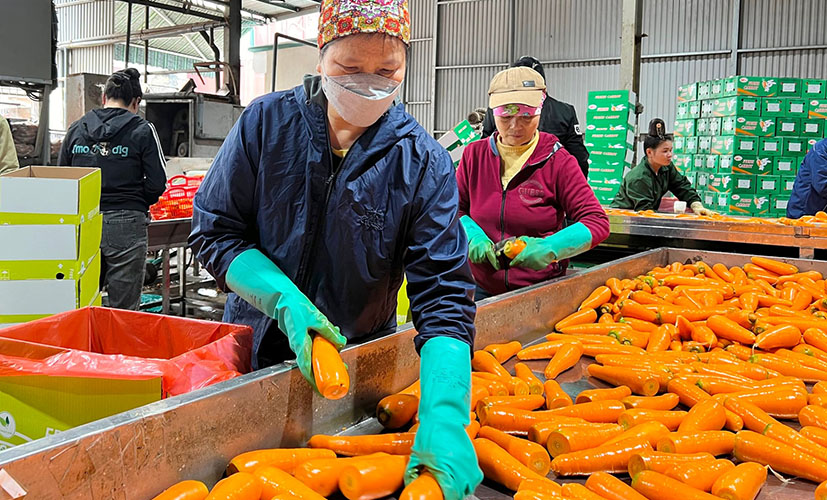
Hai Duong province has the largest area of carrot cultivation in Vietnam. In which, Duc Chinh commune is the “carrot capital” of the province. Due to high quality and large volume, it will open the huge potential for Vietnam’s carrot exports.
These days, farmers in Duc Chinh Commune are in the midst of a busy carrot harvest. Across vast fields along the Thai Binh river, local farmers are busy harvesting carrots.
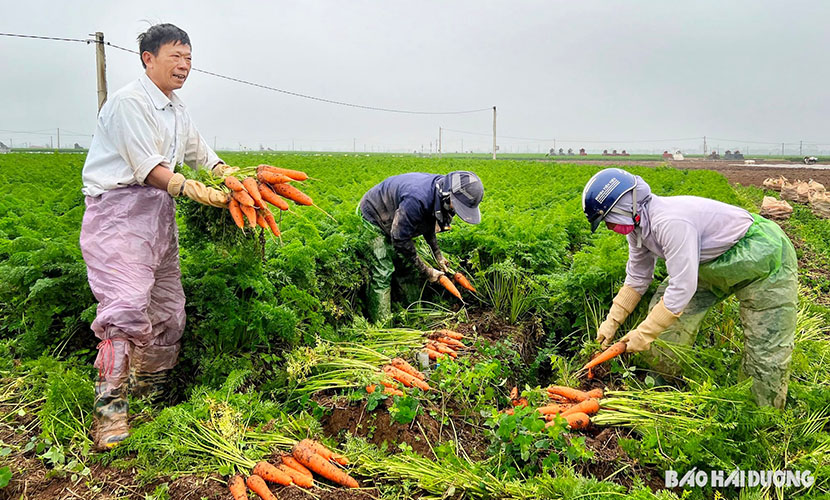
Harvesting fresh carrots
“My family’s carrot crop this year covers more than 3 mẫu (approx. 10,800 m²) and looks quite good. The average yield of fresh carrots reaches around 2.5 tons per sao (360 m²). Several traders come here to buy farms at the price of around nine million VND per sao. Accordingly, it brings a profit of five million VND per sao for local farmers,” said Mr. Bac, a farmer.
Mr. Bac also owns over one mẫu in the outer fields that produces large and high-quality carrots. He already sold to a packing house that processed for Korean market at a price of 8,000 VND per kilogram. It generated revenue of 14 million VND per sao.
There are currently 10 processing facilities of Vietnamese carrots, with a total daily capacity of 300–400 tons. At these facilities, container trucks and large vehicles come and go frequently, waiting to unload and load goods. Mr. Phung Duc Trung’s facility alone processes 80 tons per day. The carrot materials are mainly grown locally and nearby localities, along Thai Binh river.
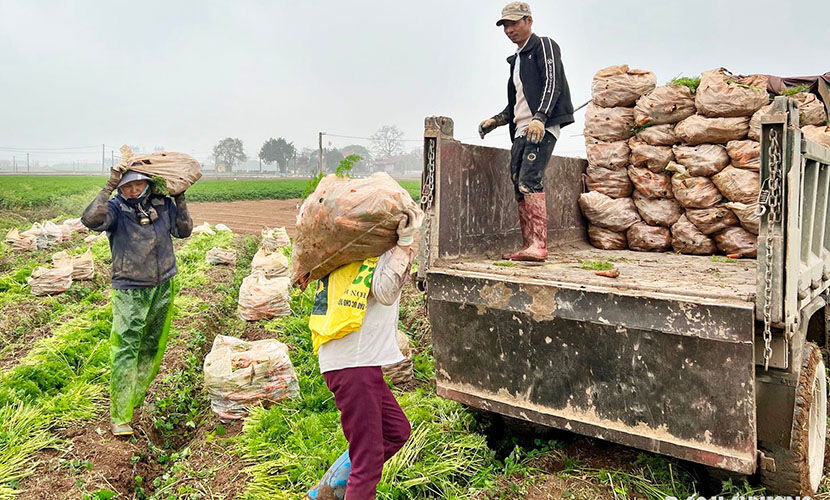
Loading carrot materials
“My packing house is pre-processing and packaging Vietnam’s carrot exports. We have traditional export markets, such as South Korea, Japan, Malaysia, and the Middle East. However, this year we open more two new markets, Laos and Thailand, with fairly large consumption volumes,” Mr. Trung said.
During the 2023–2024 winter crop, Duc Chinh commune planted over 360 hectares of carrots. It accounted for about 70% of the total carrot-growing area in Cam Giang District. Of this, 85 hectares of carrrot cultivation followed Vietgap standards, while the rest followed Vietgap-oriented practices. Total output reached 15,000 tons of fresh carrot materials.
Additionally, Duc Chinh farmers leased land in other parts of the province and neighboring provinces to cultivate another 1,100 hectares. They produced more than 40,000 tons, in which, around 80% of these were transported back to Duc Chinh for processing.
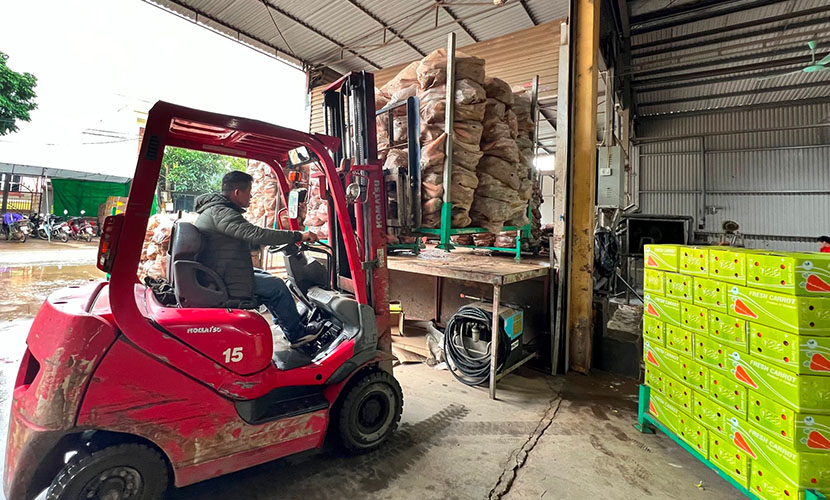
A carrot packing house in Duc Chinh commune
Mr. Thuat, Director of the Duc Chinh Cooperative, shared that the yield this season is similar to the previous one. However, the carrot quality has improved, particularly in food safety and pesticide residue control. In addition to long-term partners, there are ten new mainly foreign buyers who came to purchase Vietnamese carrot for export.
As of now, local farmers have harvested more than 50% of the total area. The volume of Vietnam’s carrot exports reached 30,000 tons (including carrots grown in other areas but processed locally). Of these, over 10,000 tons were exported to South Korea, 4,500 tons to Japan, and over 10,000 tons to new markets like Laos and Thailand. All shipments of fresh carrots to Japan and South Korea have met quality standards and none have returned.
To further enhance the quality of Vietnam’s carrot exports, the Duc Chinh Cooperative has increased training farmers on proper farming techniques and compliance with clean production processes. Local farmers only use pesticides when absolutely necessary to control harmful pests. The cooperative has encouraged farmers to invest automated irrigation systems for the entire carrot-growing area.
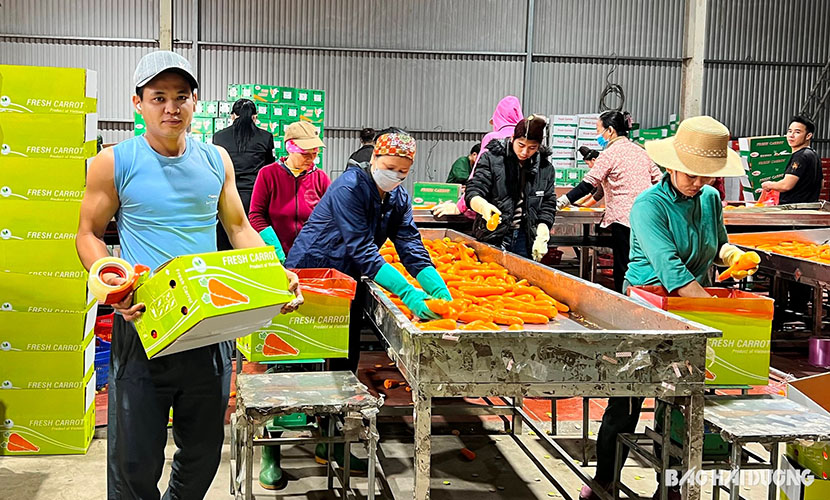
Processing and packaging Vietnam’s carrot exports
The cooperative plans to expand the Vietgap-certified carrot cultivation area by 20–30 hectares in the next crop. Additionally, it has grouped planting areas by same variety and sowing time to allow technical staff to oversee the entire cultivation process.
Besides the widely-used TI-103 carrot variety grown in recent years, the cooperative is also trialing several new varieties. If these prove to offer higher yields, better quality, and stronger resistance to pests and diseases, the cooperative will persuade farmers to expand large-scale cultivation in future seasons.
According to experts, Vietnamese carrots have great development potential due to their wide market. Currently, 70% of Hai Duong’s carrot production is intended for export and the remainder serves the domestic market.

Vietnam’s carrot exports for Korean market
To enhance value and expand export markets, Vietnam’s carrot exports should comply with phytosanitary regulations of importing countries. Only carrots grown within the local jurisdiction and subject to traceability protocols will be certified for export.
Prior to harvesting, the Hai Duong Plant Protection has also taken carrot samples from fields to test for pesticide residues. It will ensure Hai Duong carrots that comply with permissible limit of pesticides residues from high demanding markets, such as Japan and South Korea.
Vietnamese source: https://baohaiphong.vn/rong-cua-xuat-ngoai-cho-ca-rot-duc-chinh-374717.html
